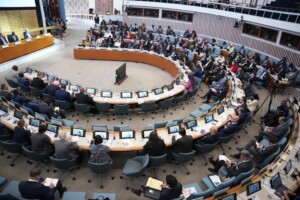Thousands left homeless by Sudan floods
A delegation from the South Darfur Health Ministry on Wednesday inspected the flood-ravaged Otash camp for the displaced, where 1,490 homes were destroyed. Floods have also caused widespread destruction across the rest of Sudan.
 Darfur: Nyala-El Fasher road damaged by flash floods this week (RD)
Darfur: Nyala-El Fasher road damaged by flash floods this week (RD)
A delegation from the South Darfur Health Ministry on Wednesday inspected the flood-ravaged Otash camp for the displaced, where a total of 1,490 homes were completely or partially destroyed, and 360 latrines, three schools, and three water stations collapsed. Floods have also caused widespread destruction across the rest of Sudan.
In southern Khartoum, Jebel Awlia locality reported that 2,273 families were affected and confirmed a case of “acute watery diarrhoea”.
Sennar
The first count in Sennar reported the collapse of more than 2,000 total and partial houses, and more than 90 per cent of the damage was reported in the horticultural sector.
The Technical Committee for Emergency in Sennar announced that more than 2,000 houses were partially and partially destroyed by the floods that hit the state.
El Gedaref
In El Gedaref, the overflowing Atbara River damaged 10 villages in El Gureisha and El Fashaga localities near the Ethiopian border. Floods washed away the iron bridge in Kona Zeburma, which led to the isolation of 5,000 people, and cut off the road to farmers. About 2,000 acres of horticultural areas were affected.
South Kordofan
In South Kordofan, floods swept through the area of Abu Karshola, which led to the collapse of 250 houses and 250 latrines, as well as property losses.
White Nile state
Flash floods in Um Ramta in White Nile state, have led to cases of diarrhoea and diseases, and destroyed eight health centres and 25 schools, including 7 secondary schools.
El Gezira
In El Gezira, the overflowing Blue Nile flooded a number of towns and villages in Kamlin locality.
Farmers have expressed their fears of the loss of the agricultural harvest this year in the state of the White Nile as a result of heavy rains and floods that hit the region recently. Ahmed Arabi said that more than 500 feddans are planted with water and that if the situation continues in this way, the agricultural season will be in danger and may affect many citizens, especially since the possibilities are low.
‘Disaster zone’
As reported by Radio Dabanga this week, the Forces for Freedom and Change (FFC) have demanded that the government declare Sudan a natural disaster zone following widespread destruction from heavy rains and flash floods that have killed 60 and injured at least 100 over the past months.
They appealed to international, regional, and local voluntary organisations to assist those affected in the affected areas.
Relief response
The UN Office for the Coordination of Humanitarian Affairs (OCHA) in Sudan reports in an update today that White Nile, Khartoum and Kassala are the states most affected by flooding.
OCHA says that the risk of water-borne disease outbreaks is high—mainly due to the presence of stagnant water in many flood-affected areas.
According to the update, Sudan’s Humanitarian Aid Commission (HAC) is leading the Floods Task Force which is coordinating and facilitating flood response efforts across the country.
The majority of needs include emergency shelter and non-food items, water, sanitation and hygiene, food and agricultural aid, health, and vector control.

Our editorial independence means that we can continue to provide factual updates about political developments to Sudanese and international actors, educate people about how to avoid outbreaks of infectious diseases, and provide a window to the world for those in all corners of Sudan. Support Radio Dabanga for as little as €2.50, the equivalent of a cup of coffee.












 and then
and then